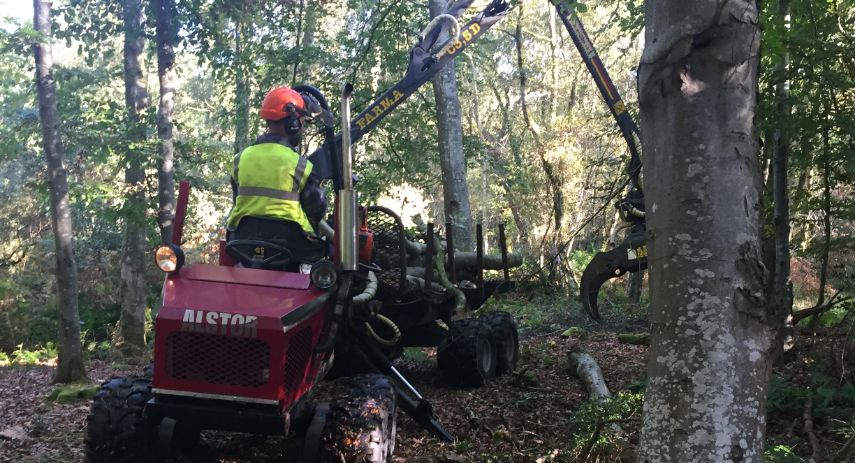
Woodlot at Caerlaverock Castle Wood
lease/licence, collaboration/management agreements
Woodlots provide a flexible way to bring small and medium-sized woodlands back into management. Using low-impact methods, woodlotters are allowed to manage a woodlot area and harvest agreed amounts of timber, in exchange for a modest fee.
The woodlots model: inspired by British Columbia, applied in Scotland
Woodlots originate from British Columbia (Canada), where individuals and families are given rights to manage areas of publicly owned forest, and to harvest timber. In British Columbia, these woodlots are often large - around 800 hectares in size.
With a lack of opportunities to own and lease land for woodland management in Scotland, the woodlots model was brought to Scotland by Andy and Gail Brown. Approximately fifteen woodlots have been created since then, on private land, but not all woodlots are up and running still. Scottish Land and Estates have been particularly helpful in bringing the woodlots model to the attention of landowners. Andy, a professional forester, manages an old ancient oak woodlot behind Caerlaverock Castle in Dumfries and Galloway. The total area of the woodlot is 32.8 ha.
The benefits for parties are evident: landlords give access to parts of their forests that are difficult or uneconomic to manage, in return for a modest fee and a well-managed forest. The woodlotter is allowed to use and manage the area and harvest an agreed amount of timber which can, for example, be used as firewood or building material.
“A group of like-minded foresters and I investigated owning a forest, but it was too expensive. We came across the woodlot model in British Columbia and realised that it was a game changer. Woodlots give people access to land and allowing people to run small land-based businesses, without having to purchase a forest.” – Andy Brown
The woodlot licence and the Woodland Management Agreement
The woodlot model is underpinned by the woodlots by the woodlot licence. The licence is a flexible agreement between the landowner and woodlotter. It is likely to outline:
- The licence period (this would ideally be a longer period like 25 years, but shorter periods like 2, 5 or 10 years could be agreed to build up relationships).
- The woodlot area.
- The licence fee payable by the woodlotter to the landowner.
- The licensee rights, for example, to work the woodlot area and fell marked trees.
- The obligations of the licensee, for example, to keep the woodlot area clean and tidy, to pay compensation in case of damage and to ensure that all persons carrying out work in the woodlot area have received appropriate training.
- How the licence can be terminated by either party, for example, with at least one month’s notice or at when the licence period expires.
Woodlot management typically involves having a Woodlot Management Plan in place which is agreed between the landowner and woodlotter and which is revised at regular intervals (e.g., every five years). The Scottish Woodlot Association provides template licences, and example of Woodlot Management Plans. The Association is a cooperative which plays a facilitative role in bringing landlords and prospective woodlotters together and aims to enable woodlotters to share skills and equipment.
Public and community benefits
The woodlot at Caerlaverock Castle shows how small-scale woodlotting can transform woodland management. The woodlot is home to large ancient oaks that had been overcrowded by birch trees. Using manual labour, low-impact techniques and horses, the middle of the wood could be reached without damaging the ground. Thinning of the forest has opened up the canopy to more light, improving conditions on the forest floor and allowing for natural regeneration. It has also improved access to the forest with a clear path for walkers. The woodlot provides approximately 100 tons of firewood per year. It also provides opportunities for education of the next generation as Andy and Gail’s children gain practical experiences with woodland management in their woodlot.
Sources:
- Interview Andy Brown, Woodlotter in D&G
- https://woodlots.scot/